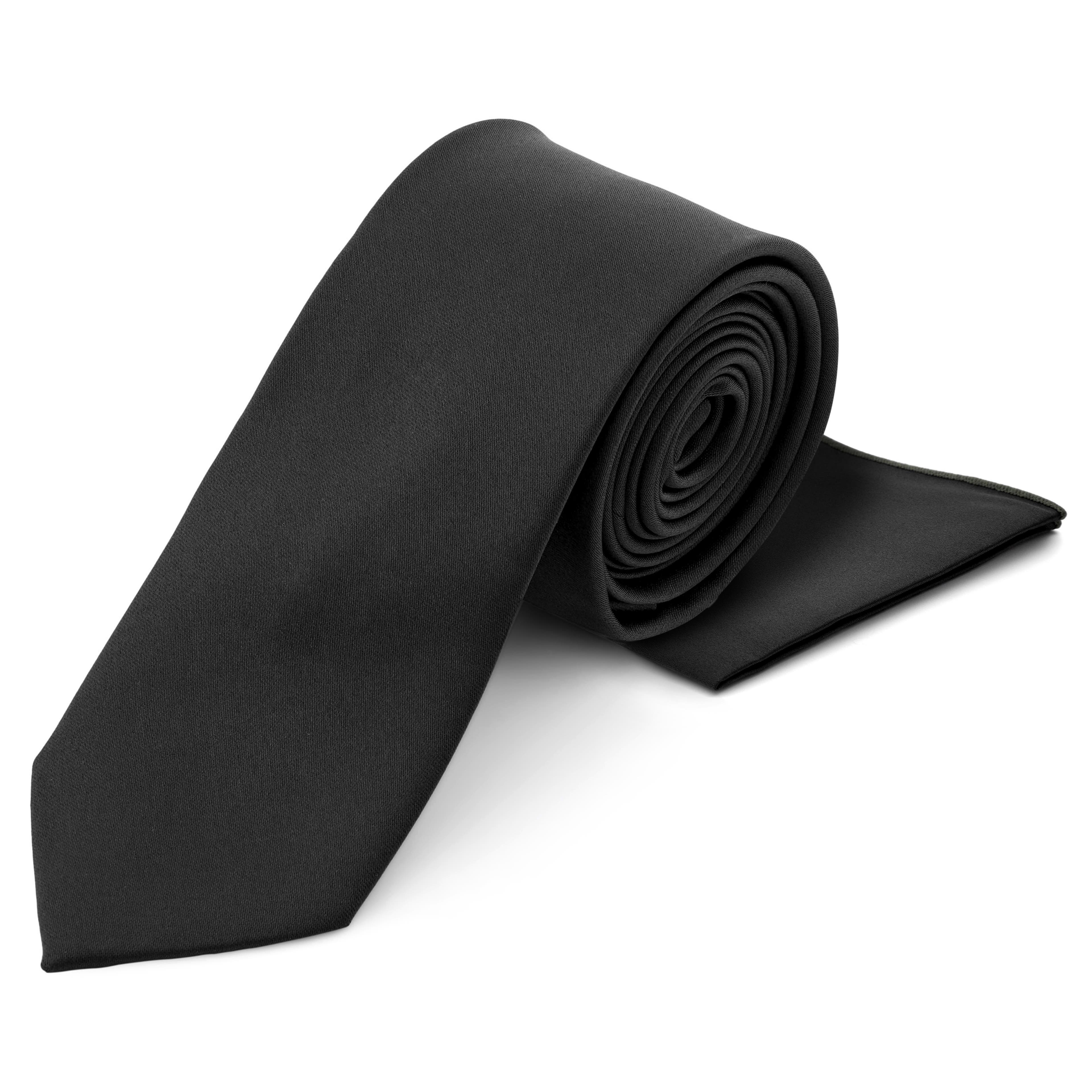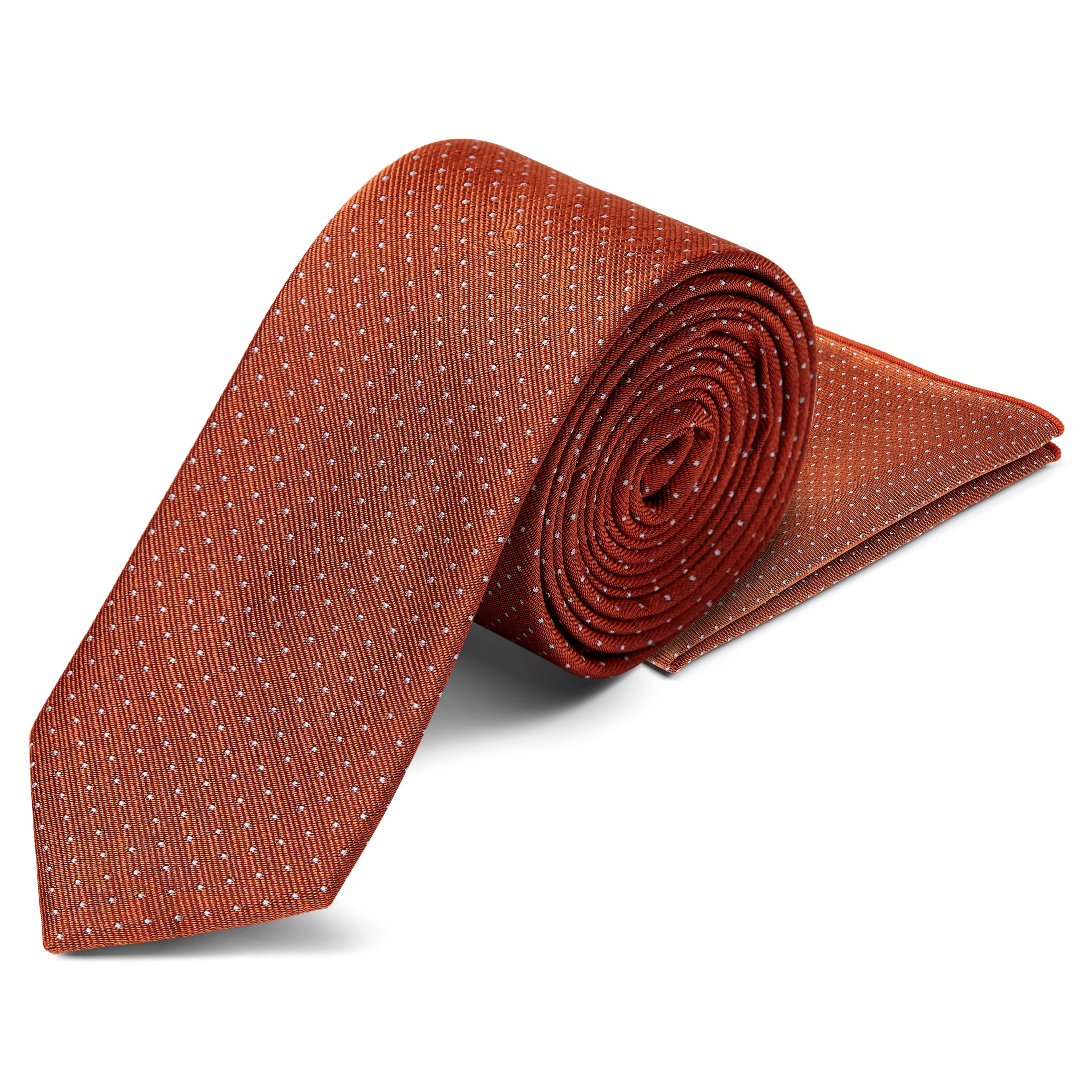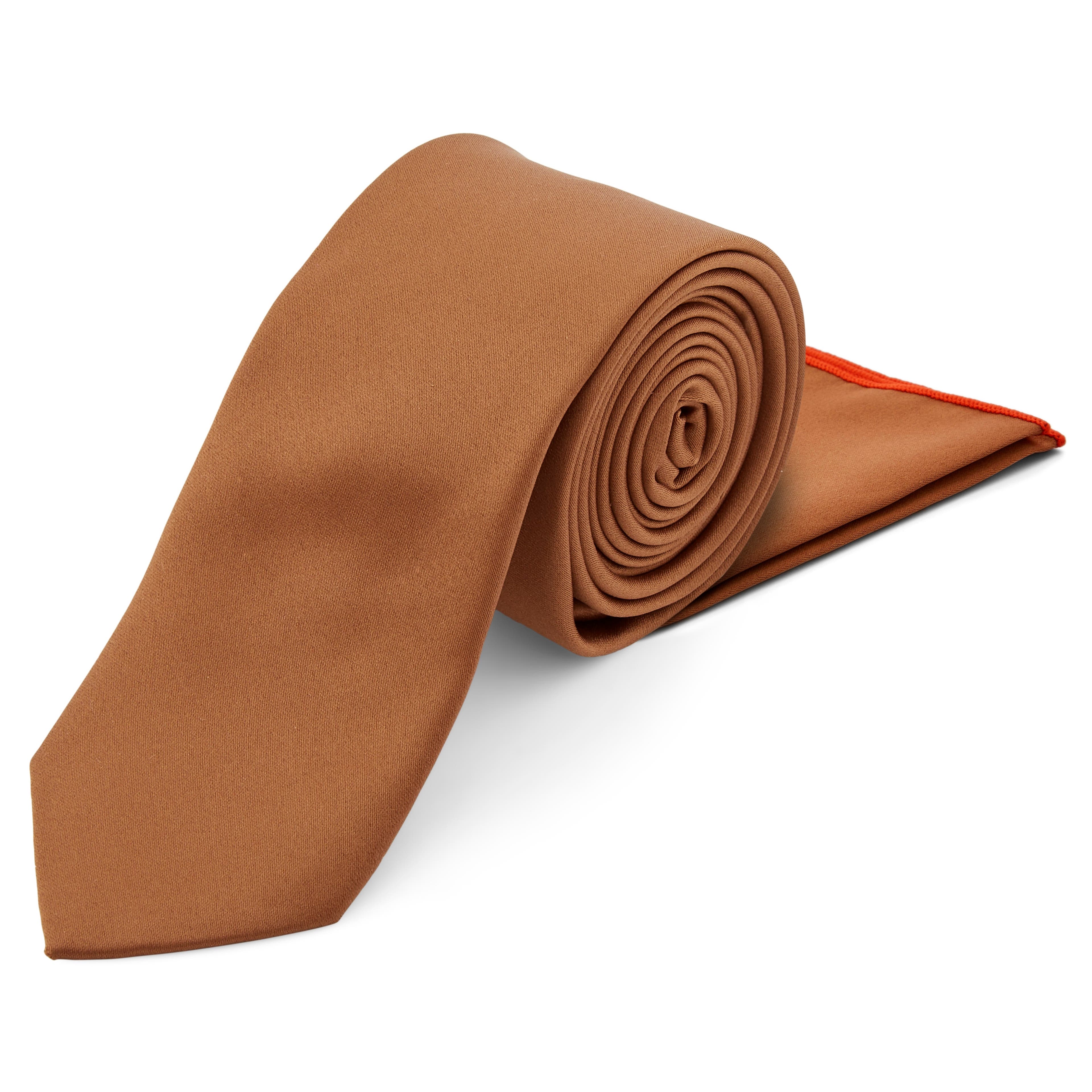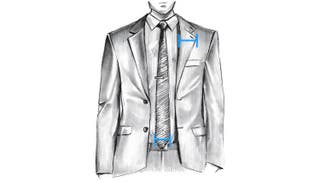Men's ties
717 products
717 products

Black Tie & Pocket Square
£24.99
Trendhim

2-Pack | Light Grey & Graphite Neckties
£34.99
Trendhim

Burgundy Necktie & Pocket Square Set
£24.99
Trendhim

Navy Blue & White Floral Pattern Cotton Necktie & Pocket Square Set
£39.99
Trendhim

Dark Brown Necktie & Pocket Square Set
£24.99
2 Colours
Trendhim

Cognac Polka Dot Silk Necktie & Pocket Square Set
£44.99
Trendhim

Light Brown Necktie & Pocket Square Set
£24.99
2 Colours
Trendhim

Blue, Pink & Green Floral Print Cotton Necktie & Pocket Square Set
£39.99
Trendhim

Blue & Bordeaux Plaid Necktie & Pocket Square Set
£29.99
Trendhim

Black & Grey Skull Paisley Pattern Silk Ascot
£49.99
Bohemian Revolt

White & Blue Paisley Pattern Silk Ascot
£49.99
Bohemian Revolt

Colourful LIGHT BLUE PAISLEY Pattern Silk Ascot
£49.99
Bohemian Revolt

BLUE & BORDEAUX CHEQUERED Pattern Silk Ascot
£49.99
Bohemian Revolt

Blue & Gold Paisley Pattern Silk Ascot
£49.99
Bohemian Revolt

Virtuo | Blue and Brown Silk Ascot
£34.99
Bohemian Revolt

Virtuo | Ivory Paisley Silk Ascot
£34.99
5 Colours
Fawler

Virtuo | Tangerine Paisley Silk Ascot
£34.99
5 Colours
Fawler

Virtuo | Mint Paisley Silk Ascot
£34.99
5 Colours
Fawler

Virtuo | Burgundy Paisley Silk Ascot
£34.99
5 Colours
Fawler

Virtuo | Green and Yellow Paisley Silk Ascot
£34.99
5 Colours
Fawler
Black & Grey Skull Paisley Pattern Silk Necktie | 6 cm
£34.99
Bohemian Revolt
White & Blue Paisley Pattern Silk Necktie | 6 cm
£34.99
Bohemian Revolt
White & Blue Paisley Pattern Silk Necktie | 8 cm
£34.99
Bohemian Revolt
Light Blue & Gold Paisley Pattern Silk Necktie | 6 cm
£34.99
Bohemian Revolt
Light Blue & Gold Paisley Pattern Silk Necktie | 8 cm
£34.99
Bohemian Revolt
Dark Blue & Dark Green PAISLEY Pattern Silk Necktie | 6 cm
£34.99
Bohemian Revolt
Colourful LIGHT BLUE PAISLEY Pattern Silk Necktie | 6 cm
£34.99
Bohemian Revolt
Colourful LIGHT BLUE PAISLEY Pattern Silk Necktie | 8 cm
£34.99
Bohemian Revolt
NAVY & LIGHT BLUE PAISLEY Pattern Silk Necktie | 6 cm
£34.99
Bohemian Revolt
NAVY & LIGHT BLUE PAISLEY Pattern Silk Necktie | 8 cm
£34.99
Bohemian Revolt
GOLD & BROWN PAISLEY Pattern Silk Necktie | 8 cm
£34.99
£27.99
Bohemian Revolt
BLUE & BORDEAUX CHEQUERED Pattern Silk Necktie | 6 cm
£34.99
Bohemian Revolt
BLUE & BORDEAUX CHEQUERED Pattern Silk Necktie | 8 cm
£34.99
Bohemian Revolt
Blue & Gold Paisley Pattern Silk Necktie | 6 cm
£34.99
Bohemian Revolt
Virtuo | 6 cm Blue and Red Silk Necktie
£44.99
2 Colours
Bohemian Revolt
Virtuo | 6 cm Blue and Brown Silk Necktie
£44.99
2 Colours
Bohemian Revolt
Virtuo | 6 cm Dark Green Paisley Silk Necktie
£44.99
2 Colours
Bohemian Revolt
Virtuo | 6 cm Dark Blue Paisley Silk Necktie
£44.99
2 Colours
Bohemian Revolt
Virtuo | 6 cm Ivory Paisley Silk Necktie
£44.99
5 Colours
Fawler
Virtuo | 6 cm Tangerine Paisley Silk Necktie
£44.99
5 Colours
Fawler
Virtuo | 6 cm Mint Paisley Silk Necktie
£44.99
5 Colours
Fawler
Virtuo | 6 cm Burgundy Paisley Silk Necktie
£44.99
5 Colours
Fawler
Virtuo | 6 cm Green and Yellow Paisley Silk Necktie
£44.99
5 Colours
Fawler
Brown and Gold-Tone Suit Accessory Set
£44.99
Trendhim
How to Tie a Tie: 30 Different Necktie Knots Book
£17.99
Trendhim
Brown and Gold-Tone Silk Suit Accessory Set
£59.99
Trendhim
Champagne Necktie and Silver-Tone Tie Bar Set
£34.99
Trendhim
Green Polka Dot Necktie and Silver-Tone Tie Bar Set
£34.99
Trendhim
Floral Necktie and Copper-Tone Tie Bar Set
£39.99
Trendhim
Terracotta Necktie and Gold-Tone Tie Clip Set
£34.99
Trendhim
Light Blue Necktie and Silver-Tone Tie Bar Set
£39.99
Trendhim
Black Necktie and Silver-Tone Tie Clip Set
£29.99
Trendhim
Floral Silk Necktie and Gunmetal Grey Tie Bar Set
£44.99
Trendhim
Paisley Necktie and Silver-Tone Tie Bar Set
£39.99
Trendhim
Black Knitted Necktie and Silver-Tone Tie Bar Set
£34.99
Trendhim
Bohemian Silk Necktie and Gold-Tone Tie Bar Set
£44.99
Trendhim
Plaid Necktie and Silver-Tone Tie Bar Set
£39.99
Trendhim
Green Dotted Necktie and Pocket Square
£24.99
Trendhim
Champagne Necktie and Pocket Square
£24.99
7 Colours
Trendhim
Paisley Necktie and Pocket Square
£29.99
3 Colours
Trendhim
Terracotta Necktie and Pocket Square
£24.99
5 Colours
Trendhim
Pale Blue Necktie and Pocket Square
£39.99
5 Colours
Trendhim
Brown Silk Necktie and Pocket Square
£44.99
3 Colours
Trendhim
Blue Silk Necktie and Pocket Square
£44.99
3 Colours
Trendhim
Autumn Necktie and Pocket Square
£24.99
5 Colours
Trendhim
Baby Blue Necktie and Pocket Square
£24.99
5 Colours
Trendhim
Petrol Blue Necktie and Pocket Square
£24.99
5 Colours
Trendhim
Crimson Necktie and Pocket Square
£24.99
7 Colours
Trendhim
Light Blue Necktie and Pocket Square
£24.99
7 Colours
Trendhim
Light Violet Necktie and Pocket Square
£24.99
7 Colours
Trendhim
Cognac Necktie and Pocket Square
£24.99
7 Colours
Trendhim
Emerald Green Necktie and Pocket Square
£24.99
7 Colours
Trendhim
Light Green Necktie and Pocket Square
£24.99
7 Colours
Trendhim
Double-Sided Pocket Square and Necktie Set With Hearts
£29.99
Trendhim
Double-Sided Pocket Square and Necktie Set With Pineapples
£29.99
Trendhim
Double-Sided Pocket Square and Necktie Set with Lobsters
£29.99
Trendhim
Double-Sided Pocket Square and Necktie Set with Sharks
£29.99
Trendhim
Double-Sided Pocket Square and Necktie Set with Planets
£29.99
Trendhim
Christmas-Themed Suit Accessory Set
£39.99
Trendhim
Pale Blue and Silver-Tone Suit Accessory Set
£54.99
Trendhim
Red Baroque Suit Accessory Set
£54.99
Trendhim
Brown and Tiger’s Eye Suit Accessory Set
£44.99
Trendhim
Emerald Green and Gold-Tone Suit Accessory Set
£34.99
Trendhim
Bordeaux and Navy Suit Accessory Set
£34.99
Trendhim
Floral and Silver-Tone Suit Accessory Set
£39.99
Trendhim
Basic Necktie Set
£99.99
Trendhim
Winter Necktie Set
£49.99
Trendhim
Autumn Necktie Set
£49.99
Trendhim
Spring Necktie Set
£49.99
Trendhim
Animal-Themed Necktie Set
£64.99
Trendhim
Knitted Necktie Set
£49.99
Trendhim
Paisley Necktie Set
£39.99
Trendhim
Floral Cotton Necktie Set
£49.99
Trendhim
Floral and Grosgrain Necktie Set
£39.99
Trendhim
Bohemian-themed Silk Necktie Set
£59.99
Trendhim
Blue Floral Necktie Set
£39.99
Trendhim
Blue Bohemian-themed Necktie Set
£54.99
Trendhim
Orange Bohemian-themed Necktie Set
£54.99
Trendhim
Dotted Necktie Set
£74.99
Trendhim
Bordeaux Necktie Set
£64.99
Trendhim
Dianthus | 6 cm Burnt Red and Blue Flower Tie
£24.99
Trendhim
Dianthus | 6 cm Purple Flower Tie
£24.99
Trendhim
Dianthus | 8 cm Burnt Orange Flower Tie
£29.99
Trendhim
Dianthus | 7 cm Burnt Orange and Turquoise Flower Tie
£24.99
Trendhim
Dianthus | 8 cm Pink Silk Flower Tie
£34.99
Trendhim
Dianthus | 8 cm Blue Silk Flower Tie
£34.99
Trendhim
Motos | 6 cm Red Small Car Tie
£24.99
Trendhim
Motos | 6 cm Green Bicycle Tie
£24.99
3 Colours
Trendhim
Motos | 6 cm Red Bicycle Tie
£24.99
3 Colours
Trendhim
Motos | 6 cm Navy Bicycle Tie
£24.99
3 Colours
Trendhim
Motos | 6 cm Green Big Car Tie
£24.99
3 Colours
Trendhim
Motos | 6 cm Navy Big Car Tie
£24.99
3 Colours
Trendhim
Motos | 6 cm Red Big Car Tie
£24.99
3 Colours
Trendhim
Zoikos | 7 cm Blue Shark Tie
£24.99
Trendhim
Zoikos | 7 cm Red Goose Tie
£24.99
Trendhim
Zoikos | 6 cm Light Blue Zebra Tie
£24.99
3 Colours
Trendhim
Zoikos | 6 cm Brown Zebra Tie
£24.99
3 Colours
Trendhim
Zoikos | 6 cm Blue Zebra Tie
£24.99
3 Colours
Trendhim
Zoikos | 8 cm Red Reindeer Tie
£29.99
Trendhim
Zoikos | 7 cm Black & White Bee Tie
£24.99
Trendhim
Zoikos | 6 cm Baby Blue Donkey Tie
£24.99
Trendhim
Zoikos | 6 cm Grey Whale Tie
£24.99
Trendhim
Zoikos | 6 cm Navy Running Dog Tie
£24.99
Trendhim
Zoikos | 6 cm Navy Dog Tie
£24.99
Trendhim
Suit Accessory Gift Box | Crimson & Royal Blue Bow Motif Set
£44.99
Trendhim
Suit Accessory Gift Box | Beige & Blue Floral-Patterned Set
£44.99
Trendhim
Suit Accessory Gift Box | Mint Green Diamond-Patterned Set.
£44.99
Trendhim
Suit Accessory Gift Box | Striped Red & Black Set
£44.99
Trendhim
Suit Accessory Gift Box | Blue Paisley & Gold-Tone Set
£44.99
Trendhim
Suit Accessory Gift Box | Striped Blue & Silver-Tone Set
£44.99
Trendhim
Suit Accessory Gift Box | Navy Blue, Red & Silver-Tone Set
£44.99
Trendhim
Suit Accessory Gift Box | Blue, White & Silver-Tone Set
£44.99
Trendhim
Suit Accessory Gift Box | Blue, Red & Silver-Tone Set
£44.99
Trendhim
Suit Accessory Gift Box | Black, Yellow & Silver-Tone Set
£44.99
Trendhim
8 cm Smoke Grey Satin Tie
£24.99
17 Colours
Trendhim
8 cm Graphite Satin Tie
£24.99
17 Colours
Trendhim
8 cm Mustard Yellow Satin Tie
£24.99
17 Colours
Trendhim
8 cm Baby Blue Satin Tie
£24.99
17 Colours
Trendhim
8 cm Silver-tone Satin Tie
£24.99
17 Colours
Trendhim
8 cm Light Grey Satin Tie
£24.99
17 Colours
Trendhim
8 cm Golden Brown Satin Tie
£24.99
17 Colours
Trendhim
8 cm Light Violet Satin Tie
£24.99
17 Colours
Trendhim
8 cm Rust Satin Tie
£24.99
17 Colours
Trendhim
8 cm Cognac Satin Tie
£24.99
17 Colours
Trendhim
8 cm Tan Satin Tie
£24.99
17 Colours
Trendhim
8 cm Champagne Satin Tie
£24.99
17 Colours
Trendhim
8 cm Crimson Satin Tie
£24.99
17 Colours
Trendhim
8 cm Arctic Blue Satin Tie
£24.99
17 Colours
Trendhim
8 cm Rose Pink Satin Tie
£24.99
17 Colours
Trendhim
8 cm Emerald Green Satin Tie
£24.99
17 Colours
Trendhim
8 cm Light Green Satin Tie
£24.99
17 Colours
Trendhim
8 cm Burgundy Grosgrain Tie
£24.99
23 Colours
Trendhim
8 cm Terracotta Grosgrain Tie
£24.99
23 Colours
Trendhim
8 cm White Grosgrain Tie
£24.99
23 Colours
Trendhim
8 cm Navy Blue Grosgrain Tie
£24.99
23 Colours
Trendhim
8 cm Black Grosgrain Tie
£24.99
23 Colours
Trendhim
8 cm Smoke Grey Grosgrain Tie
£24.99
23 Colours
Trendhim
8 cm Graphite Grosgrain Tie
£24.99
23 Colours
Trendhim
8 cm Mustard Yellow Grosgrain Tie
£24.99
23 Colours
Trendhim
8 cm Baby Blue Grosgrain Tie
£24.99
23 Colours
Trendhim
8 cm Silver-tone Grosgrain Tie
£24.99
23 Colours
Trendhim
8 cm Sea Green Grosgrain Tie
£24.99
23 Colours
Trendhim
8 cm Light Grey Grosgrain Tie
£24.99
23 Colours
Trendhim
8 cm Golden Brown Grosgrain Tie
£24.99
23 Colours
Trendhim
8 cm Light Violet Grosgrain Tie
£24.99
23 Colours
Trendhim
8 cm Rust Grosgrain Tie
£24.99
23 Colours
Trendhim
8 cm Cognac Grosgrain Tie
£24.99
23 Colours
Trendhim
8 cm Tan Grosgrain Tie
£24.99
23 Colours
Trendhim
8 cm Champagne Grosgrain Tie
£24.99
23 Colours
Trendhim
8 cm Crimson Grosgrain Tie
£24.99
23 Colours
Trendhim
8 cm Arctic Blue Grosgrain Tie
£24.99
23 Colours
Trendhim
8 cm Rose Pink Grosgrain Tie
£24.99
23 Colours
Trendhim
8 cm Emerald Green Grosgrain Tie
£24.99
23 Colours
Trendhim
8 cm Light Green Grosgrain Tie
£24.99
23 Colours
Trendhim
6 cm Smoke Grey Satin Skinny Tie
£19.99
41 Colours
Trendhim
6 cm Graphite Satin Skinny Tie
£19.99
41 Colours
Trendhim
6 cm Mustard Yellow Satin Skinny Tie
£19.99
41 Colours
Trendhim
6 cm Baby Blue Satin Skinny Tie
£19.99
41 Colours
Trendhim
6 cm Silver-tone Satin Skinny Tie
£19.99
41 Colours
Trendhim
6 cm Sea Green Satin Skinny Tie
£19.99
41 Colours
Trendhim
6 cm Light Grey Satin Skinny Tie
£19.99
41 Colours
Trendhim
6 cm Golden Brown Satin Skinny Tie
£19.99
41 Colours
Trendhim
6 cm Light Violet Satin Skinny Tie
£19.99
41 Colours
Trendhim
6 cm Rust Satin Skinny Tie
£19.99
41 Colours
Trendhim
6 cm Cognac Satin Skinny Tie
£19.99
41 Colours
Trendhim
6 cm Tan Satin Skinny Tie
£19.99
41 Colours
Trendhim
6 cm Champagne Satin Skinny Tie
£19.99
41 Colours
Trendhim
6 cm Crimson Satin Skinny Tie
£19.99
41 Colours
Trendhim
6 cm Arctic Blue Satin Skinny Tie
£19.99
41 Colours
Trendhim
6 cm Rose Pink Satin Skinny Tie
£19.99
41 Colours
Trendhim
6 cm Emerald Green Satin Skinny Tie
£19.99
41 Colours
Trendhim
6 cm Light Green Satin Skinny Tie
£19.99
41 Colours
Trendhim
6 cm Burgundy Grosgrain Skinny Tie
£19.99
41 Colours
Trendhim
6 cm Terracotta Grosgrain Skinny Tie
£19.99
41 Colours
Trendhim
6 cm White Grosgrain Skinny Tie
£19.99
41 Colours
Trendhim
6 cm Navy Blue Grosgrain Skinny Tie
£19.99
41 Colours
Trendhim
6 cm Black Grosgrain Skinny Tie
£19.99
41 Colours
Trendhim
6 cm Smoke Grey Grosgrain Skinny Tie
£19.99
41 Colours
Trendhim
6 cm Graphite Grosgrain Skinny Tie
£19.99
41 Colours
Trendhim
6 cm Mustard Yellow Grosgrain Skinny Tie
£19.99
41 Colours
Trendhim
6 cm Baby Blue Grosgrain Skinny Tie
£19.99
41 Colours
Trendhim
6 cm Silver-tone Grosgrain Skinny Tie
£19.99
41 Colours
Trendhim
6 cm Sea Green Grosgrain Skinny Tie
£19.99
41 Colours
Trendhim
6 cm Light Grey Grosgrain Skinny Tie
£19.99
41 Colours
Trendhim
6 cm Golden Brown Grosgrain Skinny Tie
£19.99
41 Colours
Trendhim
6 cm Light Violet Grosgrain Skinny Tie
£19.99
41 Colours
Trendhim
6 cm Rust Grosgrain Skinny Tie
£19.99
41 Colours
Trendhim
6 cm Cognac Grosgrain Skinny Tie
£19.99
41 Colours
Trendhim
6 cm Tan Grosgrain Skinny Tie
£19.99
41 Colours
Trendhim
6 cm Champagne Grosgrain Skinny Tie
£19.99
41 Colours
Trendhim
6 cm Crimson Grosgrain Skinny Tie
£19.99
41 Colours
Trendhim
6 cm Arctic Blue Grosgrain Skinny Tie
£19.99
41 Colours
Trendhim
6 cm Rose Pink Grosgrain Skinny Tie
£19.99
41 Colours
Trendhim
6 cm Emerald Green Grosgrain Skinny Tie
£19.99
41 Colours
Trendhim
6 cm Light Green Grosgrain Skinny Tie
£19.99
41 Colours
Trendhim
Smoke Grey Satin Cravat
£19.99
18 Colours
Trendhim
Graphite Satin Cravat
£19.99
18 Colours
Trendhim
Mustard Yellow Satin Cravat
£19.99
18 Colours
Trendhim
Baby Blue Satin Cravat
£19.99
18 Colours
Trendhim
Silver-Tone Satin Cravat
£19.99
18 Colours
Trendhim
Sea Green Satin Cravat
£19.99
18 Colours
Trendhim
Light Grey Satin Cravat
£19.99
18 Colours
Trendhim
Golden Brown Satin Cravat
£19.99
18 Colours
Trendhim
Light Violet Satin Cravat
£19.99
18 Colours
Trendhim
Rust Satin Cravat
£19.99
18 Colours
Trendhim
Cognac Satin Cravat
£19.99
18 Colours
Trendhim
Tan Satin Cravat
£19.99
18 Colours
Trendhim
Champagne Satin Cravat
£19.99
18 Colours
Trendhim
Crimson Satin Cravat
£19.99
18 Colours
Trendhim
Arctic Blue Satin Cravat
£19.99
18 Colours
Trendhim
Rose Pink Satin Cravat
£19.99
18 Colours
Trendhim
Emerald Green Satin Cravat
£19.99
18 Colours
Trendhim
Light Green Satin Cravat
£19.99
18 Colours
Trendhim
Smoke Grey Grosgrain Cravat
£19.99
18 Colours
Trendhim
Graphite Grosgrain Cravat
£19.99
18 Colours
Trendhim
Mustard Yellow Grosgrain Cravat
£19.99
18 Colours
Trendhim
Baby Blue Grosgrain Cravat
£19.99
18 Colours
Trendhim
Silver-Tone Grosgrain Cravat
£19.99
18 Colours
Trendhim
Sea Green Grosgrain Cravat
£19.99
18 Colours
Trendhim
Light Grey Grosgrain Cravat
£19.99
18 Colours
Trendhim
Golden Brown Grosgrain Cravat
£19.99
18 Colours
Trendhim
Light Violet Grosgrain Cravat
£19.99
18 Colours
Trendhim
Rust Grosgrain Cravat
£19.99
18 Colours
Trendhim
Cognac Grosgrain Cravat
£19.99
18 Colours
Trendhim
Tan Grosgrain Cravat
£19.99
18 Colours
Trendhim
Champagne Grosgrain Cravat
£19.99
18 Colours
Trendhim
Crimson Grosgrain Cravat
£19.99
18 Colours
Trendhim
Arctic Blue Grosgrain Cravat
£19.99
18 Colours
Trendhim
Rose Pink Grosgrain Cravat
£19.99
18 Colours
Trendhim
Emerald Green Grosgrain Cravat
£19.99
18 Colours
Trendhim
Light Green Grosgrain Cravat
£19.99
18 Colours
Trendhim
Green Christmas Sweater Knitted Tie
£19.99
2 Colours
Trendhim
Navy Christmas Sweater Knitted Tie
£19.99
2 Colours
Trendhim
Black Christmas Lights Tie
£19.99
4 Colours
Trendhim
Green Christmas Lights Tie
£19.99
4 Colours
Trendhim
Burgundy Christmas Lights Tie
£19.99
4 Colours
Trendhim
Navy Christmas Lights Tie
£19.99
4 Colours
Trendhim
Green Christmas Tree Tie
£19.99
3 Colours
Trendhim
Burgundy Christmas Tree Tie
£19.99
3 Colours
Trendhim
Navy Christmas Tree Tie
£19.99
3 Colours
Trendhim
Black Christmas Skull Tie
£19.99
4 Colours
Trendhim
Green Christmas Skull Tie
£19.99
4 Colours
Trendhim
Burgundy Christmas Skull Tie
£19.99
4 Colours
Trendhim
Navy Christmas Skull Tie
£19.99
4 Colours
Trendhim
Black Christmas Candy Cane Tie
£19.99
4 Colours
Trendhim
Green Christmas Candy Cane Tie
£19.99
4 Colours
Trendhim
Burgundy Christmas Candy Cane Tie
£19.99
4 Colours
Trendhim
Navy Christmas Candy Cane Tie
£19.99
4 Colours
Trendhim
Black Christmas Reindeer Tie
£19.99
3 Colours
Trendhim
Burgundy Christmas Reindeer Tie
£19.99
3 Colours
Trendhim
Navy Christmas Reindeer Tie
£19.99
3 Colours
Trendhim
Navy Blue Skinny Tie with Dinosaurs
£24.99
Trendhim
Black Skinny Tie with Sharks
£24.99
Trendhim
Black Skinny Tie with Skulls
£24.99
Trendhim
Black Skinny Tie with American Flag
£24.99
Trendhim
Navy Blue Skinny Tie with Hearts
£24.99
Trendhim
Black Skinny Tie with Planets
£24.99
Trendhim
Burgundy Skinny Tie with Math Equations
£24.99
Trendhim
Brown Skinny Tie with Fish
£24.99
Trendhim
Navy Blue Skinny Tie with Sunflowers
£24.99
Trendhim
Navy Blue Skinny Tie with Pineapples
£24.99
Trendhim
Brown Skinny Tie with Pink Flamingos
£24.99
Trendhim
Navy Blue Skinny Tie with Lobsters
£24.99
Trendhim
Burgundy Skinny Tie with Pianos
£24.99
Trendhim
Black Faux Leather Standard Tie
£19.99
Trendhim
White Faux Leather Skinny Tie
£19.99
3 Colours
Trendhim
Navy Faux Leather Skinny Tie
£19.99
3 Colours
Trendhim
Black Faux Leather Skinny Tie
£19.99
3 Colours
Trendhim
6cm Grey Silk-Twill Tie
£29.99
9 Colours
Bohemian Revolt
6cm Purple Silk-Twill Tie
£29.99
9 Colours
Bohemian Revolt
6cm Brown Silk-Twill Tie
£29.99
9 Colours
Bohemian Revolt
6cm Orange Silk-Twill Tie
£29.99
9 Colours
Bohemian Revolt
6cm Gold Silk-Twill Tie
£29.99
9 Colours
Bohemian Revolt
6cm Red Silk-Twill Tie
£29.99
9 Colours
Bohemian Revolt
6cm Burgundy Silk-Twill Tie
£29.99
9 Colours
Bohemian Revolt
6cm Navy Blue Silk-Twill Tie
£29.99
9 Colours
Bohemian Revolt
6cm Black Silk-Twill Tie
£29.99
9 Colours
Bohemian Revolt
Bryant Silk Brux Tie
£34.99
13 Colours
Bohemian Revolt
Billy Silk Brux Tie
£34.99
13 Colours
Bohemian Revolt
Bernard Silk Brux Tie
£34.99
13 Colours
Bohemian Revolt
Bryon Silk Brux Tie
£34.99
£27.99
13 Colours
Bohemian Revolt
Brad Silk Brux Tie
£34.99
13 Colours
Bohemian Revolt
Bren Silk Brux Tie
£34.99
13 Colours
Bohemian Revolt
Brannon Silk Brux Tie
£34.99
13 Colours
Bohemian Revolt
Bryce Silk Brux Tie
£34.99
13 Colours
Bohemian Revolt
Brooklyn Silk Brux Tie
£34.99
£27.99
13 Colours
Bohemian Revolt
Boyd Silk Brux Tie
£34.99
13 Colours
Bohemian Revolt
Breck Silk Brux Tie
£34.99
13 Colours
Bohemian Revolt
Blake Silk Brux Tie
£34.99
13 Colours
Bohemian Revolt
Brant Silk Brux Tie
£34.99
13 Colours
Bohemian Revolt
Celtic Knot Bolo Tie
£34.99
Fort Tempus
Butch Cassidy Bolo Tie
£34.99
2 Colours
Fort Tempus
Billy the Kidd Bolo Tie
£34.99
Fort Tempus
Doc Holliday Bolo Tie
£34.99
2 Colours
Fort Tempus
Jesse James Bolo Tie
£34.99
Fort Tempus
Alamo Dark Blue Stone Bolo Tie
£34.99
2 Colours
Fort Tempus
Tiger’s Eye Bolo Tie
£34.99
2 Colours
Fort Tempus
Wyatt Earp Bolo Tie
£34.99
£27.99
Fort Tempus
Buffalo Bill Bolo Tie
£34.99
Fort Tempus
Albuquerque Bolo Tie
£34.99
Fort Tempus
Texas Longhorn Bolo Tie
£34.99
Fort Tempus
Santa Fe Bolo Tie
£34.99
Fort Tempus
Full Moon Bolo Tie
£34.99
Fort Tempus
Wooden Tie Hanger
£9.99
Trendhim
Extra Long Dark Brown 8cm Basic Tie
£24.99
3 Colours
Trendhim
Extra Long Burgundy 8cm Basic Tie
£24.99
3 Colours
Trendhim
Extra Long Black 8cm Basic Tie
£24.99
3 Colours
Trendhim
Extra Long Navy Blue 6cm Basic Tie
£19.99
4 Colours
Trendhim
Extra Long Burgundy 6cm Basic Tie
£19.99
4 Colours
Trendhim
Extra Long Black 6cm Basic Tie
£19.99
4 Colours
Trendhim
Extra Long Autumn Yellow 6cm Basic Tie
£19.99
4 Colours
Trendhim
Stainless Steel Collar Stays
£9.99
Fort Tempus
Portfolio-Style Tie Case
£8.99
Warren Asher
Brendan Silk Boho Tie
£34.99
24 Colours
Bohemian Revolt
Braxton Silk Boho Tie
£34.99
24 Colours
Bohemian Revolt
Ben Silk Boho Tie
£34.99
24 Colours
Bohemian Revolt
Bruno Silk Boho Tie
£34.99
24 Colours
Bohemian Revolt
Bernie Silk Boho Tie
£34.99
24 Colours
Bohemian Revolt
Baron Silk Boho Tie
£34.99
24 Colours
Bohemian Revolt
Beau Silk Boho Tie
£34.99
24 Colours
Bohemian Revolt
Bruce Silk Boho Tie
£34.99
24 Colours
Bohemian Revolt
Bart Silk Boho Tie
£34.99
24 Colours
Bohemian Revolt
Bert Silk Boho Tie
£34.99
24 Colours
Bohemian Revolt
Blayney Silk Boho Tie
£34.99
24 Colours
Bohemian Revolt
Brook Silk Boho Tie
£34.99
24 Colours
Bohemian Revolt
Benjamin Silk Boho Tie
£34.99
24 Colours
Bohemian Revolt
Bilal Silk Boho Tie
£34.99
24 Colours
Bohemian Revolt
Betto Silk Boho Tie
£34.99
24 Colours
Bohemian Revolt
Benoit Silk Boho Tie
£34.99
24 Colours
Bohemian Revolt
Braden Silk Boho Tie
£34.99
24 Colours
Bohemian Revolt
Benson Silk Boho Tie
£34.99
24 Colours
Bohemian Revolt
Brice Silk Boho Tie
£34.99
24 Colours
Bohemian Revolt
Benito Silk Boho Tie
£34.99
24 Colours
Bohemian Revolt
Blaine Silk Boho Tie
£34.99
24 Colours
Bohemian Revolt
Brodie Silk Boho Tie
£34.99
24 Colours
Bohemian Revolt
Basil Silk Boho Tie
£34.99
24 Colours
Bohemian Revolt
Bjorn Silk Boho Tie
£34.99
24 Colours
Bohemian Revolt
White Crossover Tie
£19.99
3 Colours
Trendhim
Navy Crossover Tie
£19.99
3 Colours
Trendhim
Pastel Blue & Gold Stripe Navy Silk Cravat
£34.99
6 Colours
Trendhim
Pastel Blue & Red Stripe Navy Silk Cravat
£34.99
6 Colours
Trendhim
Navy Twin Stripe Green Silk Cravat
£34.99
14 Colours
Trendhim
Orange & Pastel Blue Stripe Navy Silk Cravat
£34.99
6 Colours
Trendhim
Pink & Pastel Blue Stripe Navy Silk Cravat
£34.99
6 Colours
Trendhim
Gold & Red Stripe Navy Silk Cravat
£34.99
6 Colours
Trendhim
Red & Gold Stripe Navy Silk Cravat
£34.99
6 Colours
Trendhim
Gold Twin Stripe Navy Silk Cravat
£34.99
14 Colours
Trendhim
Navy Twin Stripe Pink Silk Cravat
£34.99
14 Colours
Trendhim
Pastel Blue Twin Stripe Navy Silk Cravat
£49.99
14 Colours
Trendhim
Navy Twin Stripe Gold Silk Cravat
£34.99
14 Colours
Trendhim
Green Twin Stripe Navy Silk Cravat
£34.99
14 Colours
Trendhim
Red Twin Stripe Navy Silk Cravat
£34.99
14 Colours
Trendhim
Silver-Tone Twin Stripe Navy Silk Cravat
£34.99
14 Colours
Trendhim
Navy Twin Stripe Blue Silk Cravat
£49.99
14 Colours
Trendhim
Blue Twin Stripe Navy Silk Cravat
£49.99
14 Colours
Trendhim
Orange Twin Stripe Navy Silk Cravat
£49.99
14 Colours
Trendhim
Pink Twin Stripe Navy Silk Cravat
£34.99
14 Colours
Trendhim
Silver-Tone Twin Stripe Red Silk Cravat
£49.99
14 Colours
Trendhim
Navy Twin Stripe Red Silk Cravat
£34.99
14 Colours
Trendhim
Beige Polka Dot Silk Cravat
£34.99
7 Colours
Trendhim
Pastel Blue & Navy Stripe Silk Cravat
£49.99
6 Colours
Trendhim
Gold Polka Dot Silk Cravat
£34.99
7 Colours
Trendhim
Burnished Brown Polka Dot Silk Cravat
£34.99
7 Colours
Trendhim
Brown Polka Dot Silk Cravat
£34.99
7 Colours
Trendhim
Blue Polka Dot Silk Cravat
£34.99
7 Colours
Trendhim
Pink Polka Dot Silk Cravat
£34.99
7 Colours
Trendhim
Grey Polka Dot Silk Cravat
£34.99
7 Colours
Trendhim
Royal Blue & Navy Stripe Silk Cravat
£34.99
Trendhim
Green & Navy Stripe Silk Cravat
£34.99
6 Colours
Trendhim
Navy & Orange Stripe Silk Cravat
£34.99
6 Colours
Trendhim
Pink & Navy Stripe Silk Cravat
£34.99
6 Colours
Trendhim
Navy & Brown Stripe Silk Cravat
£34.99
6 Colours
Trendhim
Gold & Navy Stripe Silk Cravat
£34.99
6 Colours
Trendhim
Black Carbon Fibre Finish Tie Case - 12 Ties
£115.00
Warren Asher
Blue Twin Stripe Navy Silk 8cm Tie
£34.99
8 Colours
Trendhim
Green Twin Stripe Navy Silk 8cm Tie
£34.99
8 Colours
Trendhim
Navy Twin Stripe Gold Silk 8cm Tie
£34.99
8 Colours
Trendhim
Red Twin Stripe Navy Silk 8cm Tie
£34.99
8 Colours
Trendhim
Pink Twin Stripe Navy Silk 8cm Tie
£34.99
8 Colours
Trendhim
Silver-Tone Twin Stripe Navy Silk 8cm Tie
£34.99
8 Colours
Trendhim
Gold Twin Stripe Navy Silk 8cm Tie
£34.99
8 Colours
Trendhim
Navy Twin Stripe Green Silk 8cm Tie
£34.99
8 Colours
Trendhim
Red & Gold Stripe Navy Silk 8cm Tie
£34.99
5 Colours
Trendhim
Pastel Blue & Gold Stripe Navy Silk 8cm Tie
£34.99
5 Colours
Trendhim
Orange & Pastel Blue Stripe Navy Silk 8cm Tie
£34.99
5 Colours
Trendhim
Green & Gold Stripe Navy Silk 8cm Tie
£34.99
5 Colours
Trendhim
Gold & Red Stripe Navy Silk 8cm Tie
£34.99
5 Colours
Trendhim
Navy & Brown Stripe Silk 8cm Tie
£34.99
Trendhim
Blue & Navy Stripe Silk 8cm Tie
£29.99
Trendhim
Pink & Navy Stripe Silk 8cm Tie
£34.99
Trendhim
Gold & Navy Stripe Silk 8cm Tie
£34.99
Trendhim
Royal Blue & Navy Stripe Silk 8cm Tie
£34.99
Trendhim
Green & Navy Stripe Silk 8cm Tie
£34.99
Trendhim
Red & Navy Stripe Silk 8cm Tie
£34.99
Trendhim
Navy & Orange Stripe Silk 8cm Tie
£34.99
Trendhim
Brown Polka Dot Silk 8cm Tie
£34.99
12 Colours
Trendhim
Beige Polka Dot Silk 8cm Tie
£34.99
12 Colours
Trendhim
Burnished Brown Polka Dot Silk 8cm Tie
£34.99
12 Colours
Trendhim
Gold Polka Dot Silk 8cm Tie
£34.99
12 Colours
Trendhim
Navy Polka Dot Silk 8cm Tie
£34.99
12 Colours
Trendhim
Red Polka Dot Silk 8cm Tie
£34.99
12 Colours
Trendhim
Grey Polka Dot Silk 8cm Tie
£34.99
12 Colours
Trendhim
Pink Polka Dot Silk 8cm Tie
£34.99
12 Colours
Trendhim
Pastel Blue Polka Dot Silk 8cm Tie
£34.99
12 Colours
Trendhim
Black Polka Dot Silk 8cm Tie
£34.99
12 Colours
Trendhim
Blue Polka Dot Silk 8cm Tie
£34.99
12 Colours
Trendhim
Green Polka Dot Silk 8cm Tie
£34.99
12 Colours
Trendhim
Beige Polka Dot Silk 6cm Tie
£34.99
10 Colours
Trendhim
Black Polka Dot Silk 6cm Tie
£34.99
10 Colours
Trendhim
Gold Polka Dot Silk 6cm Tie
£34.99
10 Colours
Trendhim
Brown Polka Dot Silk 6cm Tie
£34.99
10 Colours
Trendhim
Burnished Brown Polka Dot Silk 6cm Tie
£34.99
10 Colours
Trendhim
Pink Polka Dot Silk 6cm Tie
£34.99
10 Colours
Trendhim
Navy Polka Dot Silk 6cm Tie
£34.99
10 Colours
Trendhim
Red Polka Dot Silk 6cm Tie
£34.99
10 Colours
Trendhim
Pastel Blue Polka Dot Silk 6cm Tie
£34.99
10 Colours
Trendhim
Green Polka Dot Silk 6cm Tie
£34.99
10 Colours
Trendhim
Red & Gold Stripe Navy Silk 6cm Tie
£34.99
4 Colours
Trendhim
Orange & Pastel Blue Stripe Navy Silk 6cm Tie
£34.99
4 Colours
Trendhim
Gold & Red Stripe Navy Silk 6cm Tie
£34.99
4 Colours
Trendhim
Green & Gold Stripe Navy Silk 6cm Tie
£34.99
4 Colours
Trendhim
Navy & Brown Stripe Silk 6cm Tie
£34.99
8 Colours
Trendhim
Gold & Navy Stripe Silk 6cm Tie
£34.99
8 Colours
Trendhim
Navy & Orange Stripe Silk 6cm Tie
£34.99
8 Colours
Trendhim
Red & Navy Stripe Silk 6cm Tie
£34.99
8 Colours
Trendhim
Pastel Blue & Navy Stripe Silk 6cm Tie
£29.99
8 Colours
Trendhim
Blue & Navy Stripe Silk 6cm Tie
£34.99
8 Colours
Trendhim
Royal Blue & Navy Stripe Silk 6cm Tie
£34.99
8 Colours
Trendhim
Silver & Navy Stripe Silk 6cm Tie
£34.99
8 Colours
Trendhim
Navy Twin Stripe Gold Silk 6cm Tie
£34.99
8 Colours
Trendhim
Navy Twin Stripe Red Silk 6cm Tie
£34.99
8 Colours
Trendhim
Navy Twin Stripe Pink Silk 6cm Tie
£34.99
8 Colours
Trendhim
Pink Twin Stripe Navy Silk 6cm Tie
£34.99
8 Colours
Trendhim
Silver-Tone Twin Stripe Red Silk 6cm Tie
£34.99
8 Colours
Trendhim
Silver-Tone Twin Stripe Navy Silk 6cm Tie
£34.99
8 Colours
Trendhim
Green Twin Stripe Navy Silk 6cm Tie
£34.99
8 Colours
Trendhim
Blue Twin Stripe Navy Silk 6cm Tie
£34.99
8 Colours
Trendhim
Burgundy & White Christmas Tie
£19.99
Trendhim
Burgundy Christmas Tie
£19.99
Trendhim
Navy Christmas Tie
£19.99
Trendhim
Black & White Striped Tie
£29.99
3 Colours
Tailor Toki
Blue Denim-Look Tie
£29.99
2 Colours
Tailor Toki
Red & Blue Striped Tie
£29.99
3 Colours
Tailor Toki
Blue & Brown Striped Tie
£29.99
3 Colours
Tailor Toki
Burgundy Stitched Tie
£29.99
2 Colours
Tailor Toki
Burgundy Bold Floral Tie
£29.99
2 Colours
Tailor Toki
Retro Blue Floral Tie
£29.99
2 Colours
Tailor Toki
Navy & White Stitched Tie
£24.99
Tailor Toki
Black Crossover Tie
£19.99
3 Colours
Trendhim
Ebony Wood Two Tiered Tie Box
£135.00
Warren Asher
Black & Silver-Tone Wooden Tie Box
£99.99
Warren Asher
Dark Green Wool Tie
£24.99
Bohemian Revolt
Burgundy Chequered Necktie
£29.99
3 Colours
Bohemian Revolt
Black Chequered Necktie
£29.99
3 Colours
Bohemian Revolt
Pale Blue Tie
£29.99
Bohemian Revolt
Cream Floral Tie
£29.99
Bohemian Revolt
Dark Blue Floral Tie
£29.99
Bohemian Revolt
Dark Grey Chequered Necktie
£29.99
3 Colours
Bohemian Revolt
Navy Wool Tie
£24.99
Bohemian Revolt
White Linen Tie
£29.99
Bohemian Revolt
Pink Cotton Tie
£29.99
Bohemian Revolt
Blue Anchor Tie
£29.99
Bohemian Revolt
Shiny Black Basic Cravat
£19.99
7 Colours
Trendhim
Shiny Black 6cm Basic Tie
£19.99
5 Colours
Trendhim
Shiny Champagne Basic Cravat
£19.99
7 Colours
Trendhim
Shiny Champagne 6cm Basic Tie
£19.99
5 Colours
Trendhim
Shiny Champagne 8cm Basic Tie
£24.99
6 Colours
Trendhim
Shiny Baby Blue Basic Cravat
£19.99
7 Colours
Trendhim
Shiny Baby Blue 8cm Basic Tie
£24.99
6 Colours
Trendhim
Shiny Gold Basic Cravat
£19.99
7 Colours
Trendhim
Shiny Gold 6cm Basic Tie
£19.99
5 Colours
Trendhim
Shiny Gold 8cm Basic Tie
£24.99
6 Colours
Trendhim
Shiny Navy Blue Basic Cravat
£19.99
7 Colours
Trendhim
Shiny Navy Blue 6cm Basic Tie
£19.99
5 Colours
Trendhim
Shiny Navy Blue 8cm Basic Tie
£24.99
6 Colours
Trendhim
Shiny Baby Pink Basic Cravat
£19.99
7 Colours
Trendhim
Shiny Baby Pink 6cm Basic Tie
£19.99
5 Colours
Trendhim
Shiny Baby Pink 8cm Basic Tie
£24.99
6 Colours
Trendhim
Shiny Red Basic Cravat
£19.99
7 Colours
Trendhim
Shiny Red 8cm Basic Tie
£24.99
6 Colours
Trendhim
Black Basic Cravat
£19.99
25 Colours
Trendhim
Black 6cm Basic Tie
£19.99
28 Colours
Trendhim
Black 8cm Basic Tie
£24.99
27 Colours
Trendhim
Lime Green Basic Cravat
£17.99
25 Colours
Trendhim
Lime Green 6cm Basic Tie
£19.99
28 Colours
Trendhim
Emerald Green Basic Cravat
£19.99
25 Colours
Trendhim
Emerald Green 6cm Basic Tie
£19.99
28 Colours
Trendhim
Emerald Green 8cm Basic Tie
£24.99
27 Colours
Trendhim
Charcoal Grey 6cm Basic Tie
£19.99
28 Colours
Trendhim
Charcoal Grey 8cm Basic Tie
£24.99
27 Colours
Trendhim
Red Basic Cravat
£19.99
25 Colours
Trendhim
Red 6cm Basic Tie
£19.99
28 Colours
Trendhim
Red 8cm Basic Tie
£24.99
27 Colours
Trendhim
Light Brown Basic Cravat
£19.99
25 Colours
Trendhim
Light Brown 6cm Basic Tie
£19.99
28 Colours
Trendhim
Light Brown 8cm Basic Tie
£24.99
27 Colours
Trendhim
Terracotta Basic Cravat
£19.99
25 Colours
Trendhim
Terracotta 6cm Basic Tie
£19.99
28 Colours
Trendhim
Terracotta 8cm Basic Tie
£24.99
27 Colours
Trendhim
Electric Purple Basic Cravat
£19.99
25 Colours
Trendhim
Light Pink Basic Cravat
£19.99
25 Colours
Trendhim
Light Pink 6cm Basic Tie
£19.99
28 Colours
Trendhim
Light Pink 8cm Basic Tie
£24.99
27 Colours
Trendhim
Turquoise Basic Cravat
£19.99
25 Colours
Trendhim
Turquoise 6cm Basic Tie
£19.99
28 Colours
Trendhim
Turquoise 8cm Basic Tie
£24.99
27 Colours
Trendhim
Mint Green Basic Cravat
£19.99
25 Colours
Trendhim
Mint Green 6cm Basic Tie
£19.99
28 Colours
Trendhim
Mint Green 8cm Basic Tie
£24.99
27 Colours
Trendhim
Leaf Green Basic Cravat
£19.99
25 Colours
Trendhim
Leaf Green 6cm Basic Tie
£19.99
28 Colours
Trendhim
Leaf Green 8cm Basic Tie
£24.99
27 Colours
Trendhim
Burgundy Basic Cravat
£19.99
25 Colours
Trendhim
Burgundy 6cm Basic Tie
£19.99
28 Colours
Trendhim
Burgundy 8cm Basic Tie
£24.99
27 Colours
Trendhim
Light Grey Basic Cravat
£19.99
25 Colours
Trendhim
Light Grey 6cm Basic Tie
£19.99
28 Colours
Trendhim
Light Grey 8cm Basic Tie
£24.99
27 Colours
Trendhim
Screaming Pink Basic Cravat
£19.99
25 Colours
Trendhim
Screaming Pink 6cm Basic Tie
£19.99
28 Colours
Trendhim
Screaming Pink 8cm Basic Tie
£24.99
27 Colours
Trendhim
Dark Brown Basic Cravat
£19.99
25 Colours
Trendhim
Dark Brown 6cm Basic Tie
£19.99
28 Colours
Trendhim
Dark Brown 8cm Basic Tie
£24.99
27 Colours
Trendhim
White Basic Cravat
£19.99
25 Colours
Trendhim
White 6cm Basic Tie
£19.99
28 Colours
Trendhim
White 8cm Basic Tie
£24.99
27 Colours
Trendhim
Salmon Pink Basic Cravat
£19.99
25 Colours
Trendhim
Salmon Pink 6cm Basic Tie
£19.99
28 Colours
Trendhim
Salmon Pink 8cm Basic Tie
£24.99
27 Colours
Trendhim
Purple Basic Cravat
£19.99
25 Colours
Trendhim
Purple 6cm Basic Tie
£19.99
28 Colours
Trendhim
Purple 8cm Basic Tie
£24.99
27 Colours
Trendhim
Dark Purple 6cm Basic Tie
£19.99
28 Colours
Trendhim
Dark Purple 8cm Basic Tie
£24.99
27 Colours
Trendhim
Light Purple Basic Cravat
£19.99
25 Colours
Trendhim
Light Purple 6cm Basic Tie
£19.99
28 Colours
Trendhim
Light Purple 8cm Basic Tie
£24.99
27 Colours
Trendhim
Blue 6cm Basic Tie
£19.99
28 Colours
Trendhim
Blue 8cm Basic Tie
£24.99
27 Colours
Trendhim
Baby Blue Basic Cravat
£19.99
25 Colours
Trendhim
Baby Blue 6cm Basic Tie
£19.99
28 Colours
Trendhim
Baby Blue 8cm Basic Tie
£24.99
27 Colours
Trendhim
Navy Blue Basic Cravat
£19.99
25 Colours
Trendhim
Navy Blue 6cm Basic Tie
£19.99
28 Colours
Trendhim
Navy Blue 8cm Basic Tie
£24.99
27 Colours
Trendhim
Screaming Orange Basic Cravat
£19.99
25 Colours
Trendhim
Screaming Orange 6cm Basic Tie
£19.99
28 Colours
Trendhim
Screaming Orange 8cm Basic Tie
£24.99
27 Colours
Trendhim
Autumn Yellow 6cm Basic Tie
£19.99
28 Colours
Trendhim
Autumn Yellow 8cm Basic Tie
£24.99
27 Colours
Trendhim
Petrol Blue Basic Cravat
£19.99
25 Colours
Trendhim
Petrol Blue 6cm Basic Tie
£19.99
28 Colours
Trendhim
Petrol Blue 8cm Basic Tie
£24.99
27 Colours
Trendhim
Canary Yellow Basic Cravat
£19.99
25 Colours
Trendhim
Canary Yellow 6cm Basic Tie
£19.99
28 Colours
Trendhim
Canary Yellow 8cm Basic Tie
£24.99
27 Colours
Trendhim
Screaming Light Pink Basic Cravat
£19.99
25 Colours
Trendhim
Screaming Light Pink 6cm Basic Tie
£19.99
28 Colours
Trendhim
Screaming Light Pink 8cm Basic Tie
£24.99
27 Colours
Trendhim
Informal Black Tie
£24.99
Tailor Toki
Tiny Dogs Tie
£24.99
Tailor Toki
Green Patterned Tie
£24.99
5 Colours
Tailor Toki
Classic Paisley Tie
£24.99
Tailor Toki
Autumn Bronze Toned Paisley Tie
£24.99
Tailor Toki
Blue, Red & Gold Striped Tie
£24.99
Tailor Toki
Light Turquoise Paisley Tie
£24.99
Tailor Toki
Burgundy Comma Patterned Tie
£24.99
Tailor Toki
Blue & Burgundy Striped Tie
£24.99
Tailor Toki
Dark Blue & Burgundy Striped Tie
£24.99
Tailor Toki
Polar Bear Tie
£19.99
Tailor Toki
Happy Whale Tie
£19.99
Tailor Toki
Santa’s Sleigh Christmas Tie
£19.99
Trendhim
Santa Many Headed Christmas Tie
£19.99
Trendhim
Santa Claus Knitted Christmas Tie
£19.99
Trendhim
Navy & Orange Paisley Polyester Ascot
£24.99
Tailor Toki
Blue Stripes & Baroque Silk Ascot
£34.99
3 Colours
Tailor Toki
Burgundy Polka Dots Geometric Silk Ascot
£34.99
Tailor Toki
Polka Dots Navy Polyester Ascot
£24.99
Tailor Toki
Red & Lavender Baroque Silk Ascot
£34.99
Tailor Toki
Brown & Purple Paisley Silk Ascot
£34.99
Tailor Toki
Purple & Black Baroque Polyester Ascot
£19.99
3 Colours
Tailor Toki
Silver Grey Paisley Polyester Ascot
£24.99
3 Colours
Tailor Toki
Blue Baroque Silk Tie
£34.99
7 Colours
Tailor Toki
Brown & Purple Paisley Silk Tie
£34.99
Tailor Toki
Red & Lavender Baroque Silk Wide Tie
£34.99
Tailor Toki
Red & Lavender Baroque Silk Tie
£34.99
Tailor Toki
Gold & Brown Paisley Polyester Wide Tie
£29.99
£23.99
4 Colours
Tailor Toki
Gold & Brown Paisley Polyester Tie
£24.99
£19.99
7 Colours
Tailor Toki
Dark Purple Paisley Polyester Tie
£24.99
7 Colours
Tailor Toki
Navy Geometric Silk Tie
£34.99
Tailor Toki
Silver Grey Paisley Polyester Wide Tie
£29.99
4 Colours
Tailor Toki
Silver Grey Paisley Polyester Tie
£24.99
7 Colours
Tailor Toki
Navy & Blue Paisley Polyester Wide Tie
£29.99
4 Colours
Tailor Toki
Navy & Blue Paisley Polyester Tie
£24.99
7 Colours
Tailor Toki
Navy & Orange Paisley Polyester Wide Tie
£29.99
Tailor Toki
Burgundy Geometric Silk Wide Tie
£34.99
Tailor Toki
Purple & Black Baroque Polyester Wide Tie
£29.99
4 Colours
Tailor Toki
Purple & Black Baroque Polyester Tie
£24.99
7 Colours
Tailor Toki
Golden Paisley Polyester Tie
£24.99
7 Colours
Tailor Toki
Brown & White Knitted Tie
£19.99
3 Colours
Tailor Toki
Navy Blue Knitted Tie
£19.99
18 Colours
Tailor Toki
Lilac Knitted Tie
£19.99
18 Colours
Tailor Toki
Yellow Knitted Tie
£19.99
18 Colours
Tailor Toki
Chocolate Knitted Tie
£19.99
18 Colours
Tailor Toki
Orange Knitted Tie
£19.99
18 Colours
Tailor Toki
Red Knitted Tie
£19.99
18 Colours
Tailor Toki
Ash Grey Knitted Tie
£19.99
18 Colours
Tailor Toki
Pine Green Knitted Tie
£19.99
18 Colours
Tailor Toki
Hot Pink Knitted Tie
£19.99
18 Colours
Tailor Toki
Burgundy Polyester Knitted Tie
£19.99
18 Colours
Tailor Toki
Yellow Knitted Tie
£19.99
18 Colours
Tailor Toki
Royal Blue Knitted Tie
£19.99
18 Colours
Tailor Toki
Lime Green Knitted Tie
£19.99
18 Colours
Tailor Toki
Black Polka Dot Knitted Tie
£19.99
2 Colours
Tailor Toki
Blue & Red Knitted Tie
£19.99
Tailor Toki
Navy Blue Striped Knitted Tie
£19.99
2 Colours
Tailor Toki
Autumn Reds Knitted Tie
£19.99
3 Colours
Tailor Toki
Formal Blue Knitted Tie
£19.99
3 Colours
Tailor Toki
Blue Striped Knitted Tie
£19.99
3 Colours
Tailor Toki
Grey & Blue Knitted Tie
£19.99
3 Colours
Tailor Toki
Blue & White Knitted Tie
£19.99
Tailor Toki
Army Green Knitted Tie
£19.99
18 Colours
Tailor Toki
Pastel Blue Knitted Tie
£19.99
18 Colours
Tailor Toki
Cornflower Blue Knitted Tie
£19.99
18 Colours
Tailor Toki
Purple Knitted Tie
£19.99
18 Colours
Tailor Toki
Mahogany & White Knit Tie
£19.99
2 Colours
Tailor Toki
Navy Stripes Knitted Tie
£19.99
3 Colours
Tailor Toki
White Tulips Knitted Tie
£19.99
Tailor Toki
Blue Cable Knitted Tie
£19.99
Tailor Toki
Black & White Striped Knitted Tie
£19.99
Tailor Toki
Pink & Blue Knitted Tie
£19.99
Tailor Toki
Navy Blue & Brown Knitted Tie
£19.99
Tailor Toki
Mahogany Tapestry Tie
£24.99
5 Colours
Tailor Toki
Purple Tapestry Tie
£24.99
5 Colours
Tailor Toki
Blue Tapestry Tie
£24.99
5 Colours
Tailor Toki
Green Tapestry Tie
£24.99
5 Colours
Tailor Toki
Blue & White Floral Tie
£29.99
Tailor Toki
Brown Chequered Handmade Tie
£24.99
Tailor Toki
Blue Chequered Handmade Tie
£24.99
Tailor Toki
Raw Handmade Dark Gray Tie
£24.99
2 Colours
Tailor Toki
Raw Handmade Brown Tie
£24.99
Tailor Toki
Raw Handmade Dark Bordeaux Tie
£24.99
Tailor Toki
Raw Handmade Red Tie
£24.99
2 Colours
Tailor Toki
Navy Blue Dotted Cotton Tie
£29.99
5 Colours
Tailor Toki
Pink Dot Cotton Tie
£24.99
5 Colours
Tailor Toki
Red Dot Cotton Tie
£29.99
5 Colours
Tailor Toki
White & Black Dot Cotton Tie
£29.99
5 Colours
Tailor Toki
Black & White Dotted Cotton Tie
£29.99
5 Colours
Tailor Toki
White Dotted Cotton Tie
£29.99
2 Colours
Tailor Toki
Black Dot Cotton Tie
£29.99
2 Colours
Tailor Toki
Gray Linen Tie
£24.99
Tailor Toki
Dotted Silk Tie
£34.99
Tailor Toki
Blue Chequered Silk Tie
£34.99
Tailor Toki
Retro Dot Silk Ties
£34.99
Tailor Toki
Red Paisley Silk Tie
£34.99
Tailor Toki
Flowered Paisley Silk Tie
£34.99
Tailor Toki
Orange Paisley Silk Tie
£34.99
Tailor Toki
Yellow Paisley Silk Tie
£34.99
Tailor Toki
White Polka Dot Silk Tie
£34.99
Tailor Toki
Black Patterned Silk Tie
£34.99
Tailor Toki
Green Dotted Tie
£19.99
Tailor Toki
Green & Brown Camouflage Tie
£24.99
Tailor Toki
Blue / White Floral Tie
£29.99
Tailor Toki
Classic Black Lined Tie
£19.99
Tailor Toki
Blue Flower Tie
£29.99
Tailor Toki
Blue Mini Flower Tie
£24.99
Tailor Toki
Blue & Bordeaux Plaid Tie
£24.99
Tailor Toki
Blue Paisley Tie
£24.99
Tailor Toki
Blue Music Tie
£24.99
Tailor Toki
Black and Blue Plaid Tie
£24.99
Tailor Toki
Blue Daisy Tie
£24.99
Tailor Toki
Dark Blue Dotted & Clover Tie
£24.99
2 Colours
Tailor Toki
Bordeaux Dotted Tie
£24.99
2 Colours
Tailor Toki
Dark Blue Dotted Tie
£24.99
Tailor Toki
Retro Cashmere Wool Tie
£44.99
2 Colours
Tailor Toki
Gray Cashmere Wool Tie
£44.99
2 Colours
Tailor Toki
Bright Grey Design Wool Tie
£24.99
Tailor Toki
Gray Executive Wool Tie
£24.99
Tailor Toki
Black & White Detail Wool Tie
£24.99
Tailor Toki
Black Narrow Wool Tie
£24.99
Tailor Toki
Winter Knitted Tie
£19.99
Tailor Toki
Navy Knitted Tie
£19.99
2 Colours
Tailor Toki
Blue & White Chequered Tie
£24.99
Tailor Toki
Blue Chequered Tie
£24.99
Tailor Toki
Red Chequered Tie
£24.99
Tailor Toki
Pink Microfiber Tie
£24.99
2 Colours
Tailor Toki
Navy & White Microfiber Tie
£24.99
Tailor Toki
Purple Stripe Microfiber Tie
£24.99
2 Colours
Tailor Toki
Dark Blue Striped Tie
£19.99
Tailor Toki
Dark Blue Tie
£19.99
Tailor Toki
Purple & Pink Plaid Tie
£24.99
Tailor Toki
Blue Orange-Dotted Tie
£24.99
Tailor Toki
Blue Red-Dotted Tie
£19.99
Tailor Toki
Black Knitted Tie
£19.99
18 Colours
Tailor Toki
Retro Wool Tie
£24.99
Tailor Toki
Black Faux Leather Tie
£19.99
Tailor Toki

Find your perfect colour

Choose the material that suits you best
How far down should a proper tie hang?
Throughout history, ties have been worn at different lengths, dictated directly by the edicts of each era's prevailing fashion. Today's sweet spot is just at the top of or half way down the belt.
.jpg?format=pjpg&auto=webp&quality=75%2C90&width=320)
Guide to appropriate tie width
Many men mistakenly believe that the modern look is narrow or semi-narrow ties, but there is a rule of thumb that dictates the width of your tie at its widest, should be the same as the width of your jacket's lapel. Please refer to the illustration below.

Neckties in various materials
Beyond the actual appearance of the ties, there are other matters to consider when making your selections. We have tried to make your choices more manageable by discussing the characteristics of the various materials that our ties are made from.
Silk Ties
Pros:
Silk is a soft lustrous fibre produced by silk worms. This natural material makes the tie drape perfectly where it hangs.
Silk ties have unique colourations and wonderful light reflections.
Silk ties can be ironed but at the lowest heat setting only.
Cons:
In comparison, silk ties are more expensive than other materials.
Silk is less resistant to water and stains.
It is wiser to store silk ties in a rolled up coil than on a tie rack.
Polyester Ties
Pros:
Polyester is resistant to both water and stains.
Very resistant to curling up.
Polyester ties are less fragile than silk and hold there colours well over their lifetimes.
Much less expensive, costing as little as half of what you would pay for a silk tie.
Cons:
Polyester does not breathe, unlike natural materials do, so on hot summer days you can get a damp and sticky feeling around your neck.
Polyester does absorb odours such as those of smoke and sweat.
Polyester does not wrinkle which is a good thing because that synthetic material absolutely abhors heat sources, especially from an iron.
Cotton Ties
Pros:
Natural cotton is a material that breathes well so that it is suitable for anytime of year.
Fleecy cotton material.
Cons:
Can easily lose its shape and curl upward.
Flax Fibre Ties
Pros:
Flax is a fluffy material that even a small breeze will ruffle.
This fibre also breathes so it is ideal for summer ties.
Cons:
Flax is a relatively strong material but is likely to curl more easily.
Woolen Ties
Pros:
Either woven or knitted, wool ties drape very well.
Cons:
Somewhat resistant to moisture.
There are many qualities of wool available but the higher ends, such as cashmere wool, can be a little pricey.
Because of their natural warming properties they are more appropriate for the cooler times of the year.






























